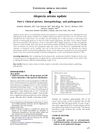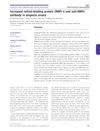TLDR People with alopecia areata have higher levels of RBP4 protein and antibodies against it.
The study compared serum protein profiles of 15 patients with biopsy-confirmed alopecia areata (AA) to those of 15 healthy controls and found that RBP4 expression was significantly upregulated in AA patients. Serum levels of RBP4 were higher in AA patients (mean ± SD: 49,233.47 ± 13,590.86 ng/mL) compared to healthy controls (mean ± SD: 32,408.80 ± 8,883.29 ng/mL) and male pattern hair loss patients (mean ± SD: 32,946.33 ± 9,041.21 ng/mL). Additionally, 67% of AA patients had IgG reactivity to recombinant human RBP4, compared to 13% of healthy controls and 7% of male pattern hair loss patients. The study concluded that the increased serum levels of RBP4 and positive IgG immunoreactivity against RBP4 in AA patients suggest an involvement of the retinoic acid biosynthesis pathway in the disease's pathogenesis, although further research is needed to understand the clinical significance and precise role of RBP4 in AA.
 6 citations
,
November 2010 in “Histochemistry and cell biology”
6 citations
,
November 2010 in “Histochemistry and cell biology” The proteins transthyretin and megalin are more present in the growth phase of hair, suggesting they might affect hair health and growth.
66 citations
,
July 2010 in “Journal of Proteome Research” Trichohyalin may trigger the immune response causing alopecia areata.
717 citations
,
June 2010 in “Nature” Alopecia areata involves both innate and adaptive immunity, with specific genes linked to the disease.
 391 citations
,
January 2010 in “Journal of The American Academy of Dermatology”
391 citations
,
January 2010 in “Journal of The American Academy of Dermatology” Half of people with Alopecia Areata may see hair regrowth within a year without treatment, but recovery is unpredictable.
44 citations
,
October 2009 in “Journal of the American Academy of Dermatology” Topical bexarotene 1% gel might help regrow hair in alopecia areata and is generally safe.
48 citations
,
March 2007 in “The journal of investigative dermatology/Journal of investigative dermatology” Retinoic acid production and signaling in hair follicles are regulated by location and timing, affecting hair growth and cycling.
148 citations
,
September 2003 in “Journal of Investigative Dermatology Symposium Proceedings”
 6 citations
,
June 2011 in “British Journal of Dermatology”
6 citations
,
June 2011 in “British Journal of Dermatology” People with alopecia areata have higher levels of RBP4 protein and antibodies against it.



